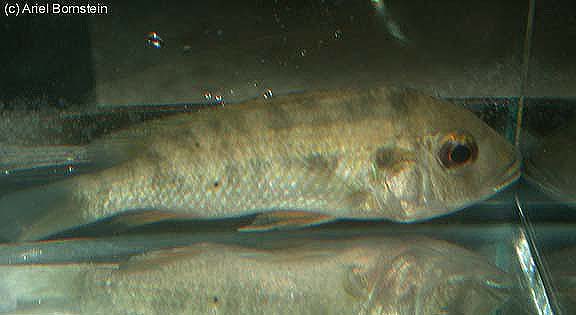| Cichlidae (Cichlids), subfamily: Pseudocrenilabrinae |
| 12.6 cm SL (male/unsexed) |
|
benthopelagic; freshwater |
| Africa: endemic to Lake Bermin, Cameroon (Ref. 52307, 81260). |
|
Dorsal spines (total): 14-16; Dorsal soft rays (total): 11-12; Anal spines: 3-3; Anal soft rays: 7-9. Diagnosis: lower pharyngeal jaw slender and gracile, with a reduced dentigerous plate; gill filaments of first arch short (ca. 10% of head length); 13-16 fleshy gill rakers on first arch; anterior gill rakers not markedly reduced in size (Ref. 81260).
Description: body moderately slender (Ref. 52307). Head relatively large, not massive (Ref. 52307), its length 35.6-42.3% SL (Ref. 81260). Lower pharyngeal jaw with weakly bicuspid, curved anterior teeth and straight bicuspid posterior teeth; ventral keel shorter than dentigerous plate; 2-3 rows of teeth in upper jaw, outer row teeth usually bicuspid, but occasionally unicuspid (Ref. 81260).
Coloration: reddish bronze, darkest dorsally on flanks; snout, cheek and opercle blood-red; upper lip black, lower lip brilliant white (Ref. 52307, 81260). Belly reddish bronze; slight whitish tinge to fleshy base of pectoral fin; well marked black opercular spot; dorsal fin dusky-black with reddish hue over soft ray membrane; caudal fin red proximally, with black distal border and lower lobe; anal fin red proximally, with black distal border; pelvics black; pectoral fins reddish (Ref. 81260). |
| Prefers to live at depths greater than 8 m; seems to have adapted to greater depths and reduced dissolved oxygen levels; feeds mainly upon vegetative materials (higher plants and algae (Ref. 52307). Probably a pair-bonding, open (Ref. 52307) substrate brooder/spawner (Ref. 52307, 81260), with both parents guarding the brood (Ref. 52307). |
|
Critically Endangered (CR); Date assessed: 16 February 2009 (B1ab(iii)+2ab(iii)) Ref. (130435)
|
| harmless |
Source and more info: www.fishbase.org. For personal, classroom, and other internal use only. Not for publication.

